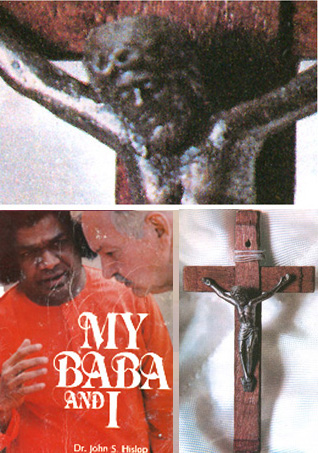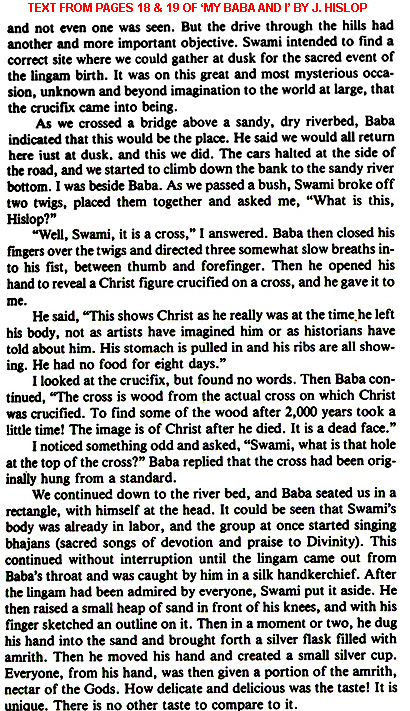Alleged miracle crucifix materialised for Dr. John Hislop

The crucifix given to
John Hislop was supposed to have been materialized by the paranormal powers of
Sai Baba. The question as to the plausibility of a true
materialization which reproduces such details as air bubbles identical with
those caused by techniques of inexpensive mass reproduction, and standard but
historically inaccurate iconographic features such as nails through
palms.
For hundreds of thousands of readers, The book My Baba and I by Dr. John Hislop, [1985: Birth Day Publishing, San Diego] has been read very widely and it is translated into many languages. The title was given to Hislop by Sai Baba. The book reports on Hislop’s prolonged and intimate experiences of Baba’s teachings, some alleged miracles (notably that of the famous Crucifix materialised for Hislop by Baba on Mahashivaratri, 1973. This occurred on a car trip to have a picnic. See Hislop's account:-

Dr. John Hislop readily believed what Sai Baba told him, namely, that the crucifix was made from a piece of the original wood of the Cross. Of course, no carbon dating was done – for it would surely disprove that. Serious scientists would not bother to go to such lengths to disprove such a cheap trick, and Hislop would never have tried because he worked entirely on blind faith.
However, a magnified photo of the amulet was examined by an art expert emeritus professor and proclaimed most likely to be a commonly manufactured amulet from 19th century UK, with visible small defects due to the mass/casting process. There is a serious defect in the crucifix too, for the nails in actual crucifixions passed through the wrist, because nails through the hand could not support a weight of the body. It also has a hole at the top of the cross, so Hislop asked his Lord and master what it was. Sathya Sai Baba, improvising as usual, told him the cross had been suspended from above!
The same kind of small crucifix is available from shops and markets in India for a small amount of money. The hole is quite evidently for a locket chain so it can be worn around the neck, not for Sathya Sai’s reason - i.e. hanging of the original cross from above. (See “The fake crucifix” and also comments at http://www.exbaba.com/articles/premanand3.html).
Piet Vroon, wrote in “Santa Claus in India” in Indian Skeptic 6(4), August 1993: 8-16. an article (which appeared on Saturday December 5, 1992 in De Volkskrant (a Dutch national newspaper, under the title ‘Sinterklaas in India’):-
”The crucifix given to John Hislop was supposed to have been materialized by the paranormal powers of Sai Baba. The question might also be raised as to the plausibility of a true materialization which reproduces such details as air bubbles identical with those caused by techniques of inexpensive mass reproduction, and standard but historically inaccurate iconographic features such as nails through palms.”
These trips were then arranged by the Sathya Sai servitor, Colonel Joga Rao, who did not believe in Sai miracles, but who evidently conspired with Sai Baba to facilitate the fraudulence. Joga Rao’s reason for this reportedly was that Sai Baba would thereby become able to get funds to help the poor etc.. On Mahashivartri Day of 1973, Sai Baba took Hislop and others on a car trip in the morning:-
"Baba indicated that this would be the place. He said we would all return here just at dusk..."
COMMENT: Sai Baba's indication of the sandy site was noted by his helper, Joga Rao, no doubt, so the silver flash could be buried in advance! Further, at dusk it is harder to see details and a good time for sleight-of-hand!
" Baba then closed his fingers over the twigs and directed three somewhat slow breaths into his fist, between thumb and forefinger. Then he opened his hand to reveal a Christ figure crucified on a cross..."
COMMENTS: The situation chosen was unexpected for a 'miracle' and rather confusing. Closing his hand to conceal the twigs and taking his time to blow on it... this is a technique used often by him (I have seen it very close-up myself). It will be preceded by some clever misdirection of attention while the switch is made.
(NOTE: The taste of 'amrith' is nothing but exactly that of Tea Rose! see here)